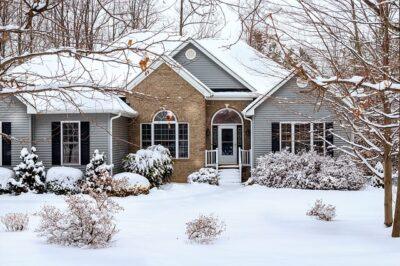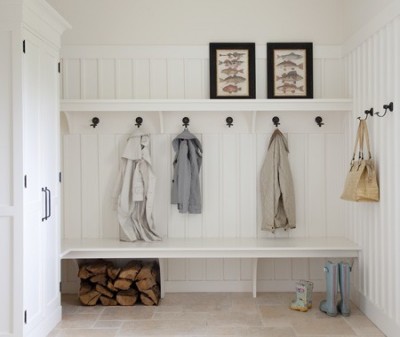As the weather turns colder, thoughts are no doubt turning to adding insulation, sealing leaks, and pulling the wool rugs out of storage. Properly winterizing your home helps keep energy costs down and spirits high once Jack Frost moves in.
The doors and windows to your home can be challenging to properly insulate, however, and will remain vulnerable to heat loss. Consider preventing some of this vulnerability with the addition of a mud room to provide a buffer between your home and the inhospitable conditions.
Although you can install well-insulated fiberglass exterior doors to keep weather out, nothing compares to the insulation offered by an interior wall. A mud room is a vestibule built along the side of the main dwelling which separates the door from the outside. Whether fully insulated or not, it functions as an airlock and prevents the full force of wind, rain and snow from having access to the exterior door. Consequently, less cold air and moisture finds their way inside. A mud room will even provide your home with protection from heat, making it more energy-efficient in summertime, too.
Design your vestibule to be small to moderate size; the smaller it is, the more effectively it will function to save energy. Keep it in proportion with the façade of the house, so it will not seem to be an afterthought, and leave enough interior room to organize it for functionality. You may eventually want to add furniture such as seating or a small table inside. Plan on at least one window to permit light into the space, open it up, and allow a view out while dressing for the weather. Draw up blueprints for your mud room, bearing in mind all future plans.
Once you have decided on the size of your addition and created blueprints, you are ready to survey and build. Enlist experienced help if this is your first construction project, but most homesteaders can plan on this work to be hands-on. You needn’t plan on using premium materials for construction; the vestibule is essentially an outbuilding and should be constructed with sound but not necessarily expensive materials. A concrete foundation will ensure your mud room will last a lifetime. Plywood for walls, joists and roof will suffice, covered with siding to match the house and asphalt roll roofing or similar. Take care to select a well-constructed door and energy efficient windows.
Within the addition, be careful to install interior wiring for fixtures and electrical outlets safely and properly. Do not run heating ducts from the house, as this would work against the purpose of the vestibule, but you may choose to add a well-insulated heat sink. Linoleum or tile flooring will be easiest to care for in this muddy area; in warmer climates a sealed subfloor might be sufficient. If you are in a very cold climate, you will definitely want to consider adding insulation to the mud room floor and perhaps the walls. If you install a layer of rigid board insulation beneath the flooring, you will be more comfortable when you remove boots and shoes even though the space isn’t heated. Rugs can also help, but will need to be hard-wearing as they will bear the brunt of tracked in snow and mud. Bear in mind this isn’t a room for living, however, but just a transition zone.
After construction and finishing are complete, discipline your family to use the mud room as a primary entrance, regardless of its location on the house. Add seating and storage for outdoor clothing such as coat hooks and a boot rack to encourage the removal of wet and muddy things to dry, saving you from having to clean up messes indoors. Set up a space for keys, mail, tools, equipment and outdoor toys, to keep it all from entering the house.
If you have a “drop zone,” an area where everything that is carted out of the house seems to collect in piles, you can move this into the mud room. Designate a basket or small table within the space for all this clutter, and watch it fall into place. Design the mud room around the behavior of your family; it is much easier than trying to work the other way!
Whether you call it your porch, sunroom or mud room, the addition of a transition space protecting your main entrance will make your home noticeably warmer and more organized within its first cold season. A mud room should be seriously considered, especially for homes in wet and cold climates, as a straightforward and inexpensive way to make a big difference to the comfort, security and standard of living of your family; it’s not just a way to put a pretty face on your house (but it does that, too).
Have you ever built a mud room, or do you have one? What advice would you add? Share your tips in the section below:
Learn Dozens Of Organic Gardening Secrets And Tricks. Read More Here. [4]

